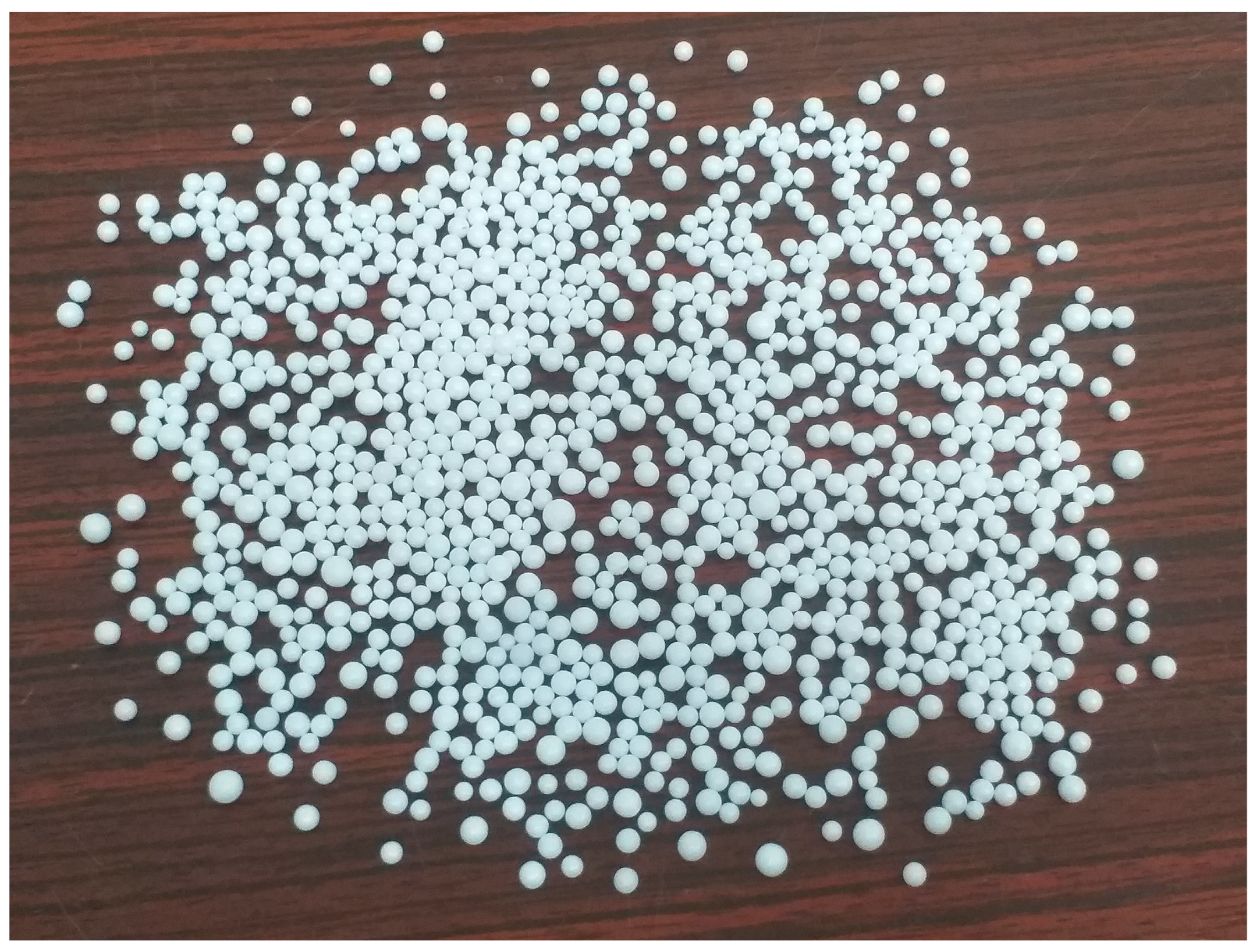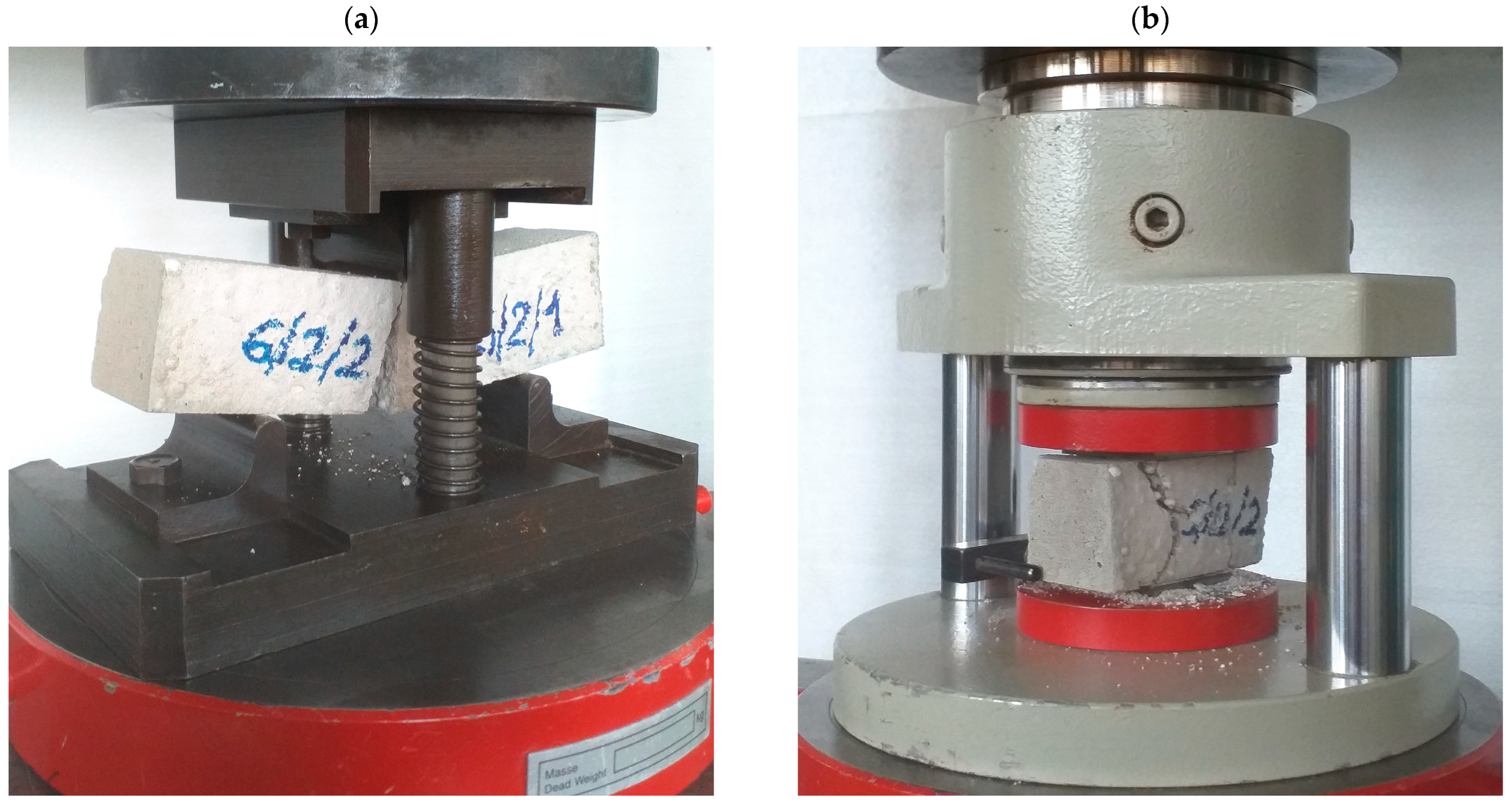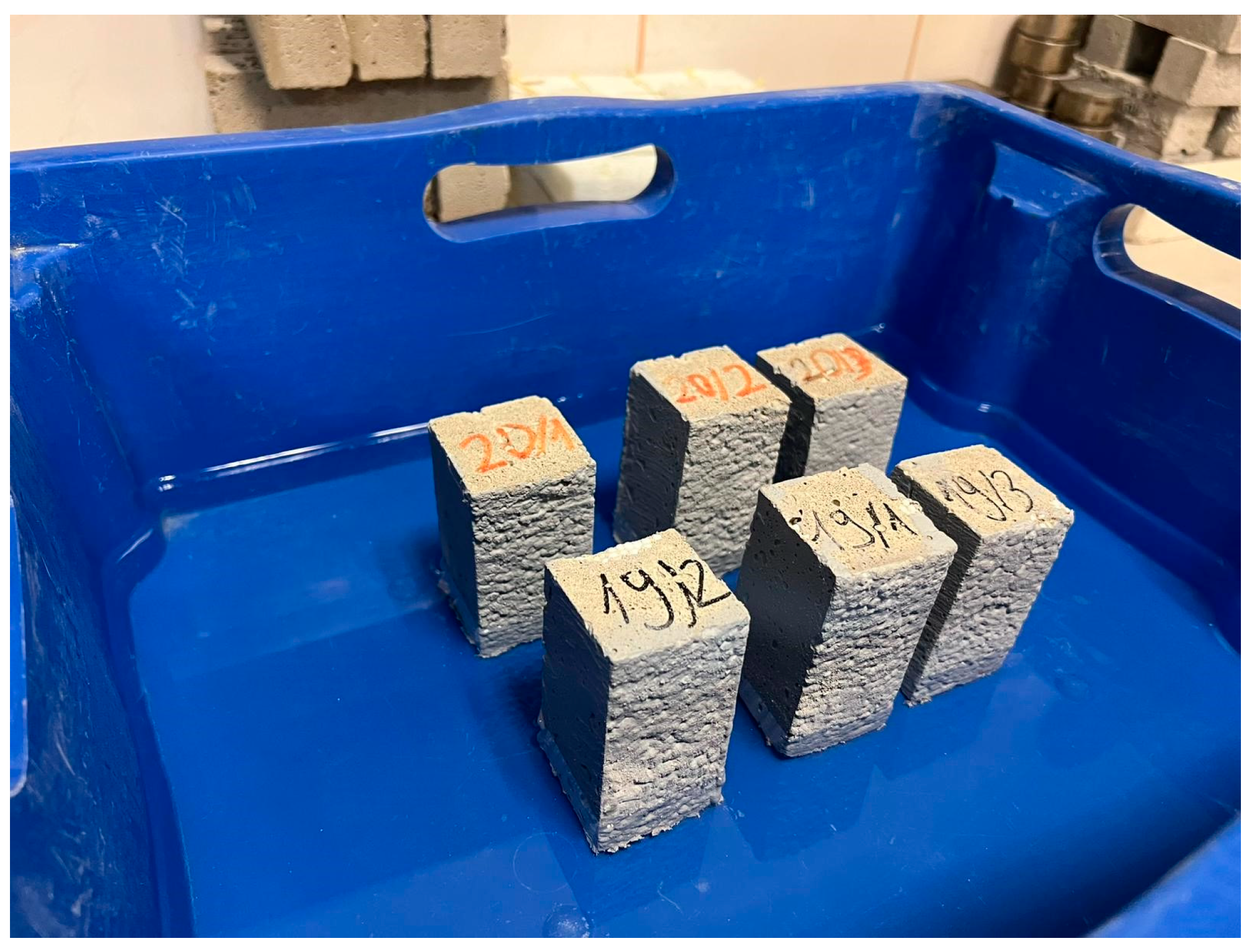Physical Properties of Foamed Concrete Based on Plaster Mortar with Polystyrene Granulate and Synthetic Foaming Agent
Abstract
1. Introduction
2. Materials and Methods
2.1. Specimen Preparation
2.2. Mix Composition
2.3. Mix Production
2.4. Methodology
2.4.1. Density
2.4.2. Thermal Conductivity
2.4.3. Flexural Strength
2.4.4. Compressive Strength
2.4.5. Water Absorption Coefficient Due to Capillary Action
- M1 is the sample weight after storage in water for 10 min [g] and
- M2 is the sample weight after storage in water for 90 min [g].
3. Results and Discussion
- bi is the model parameter (regression coefficient) describing the impact of the i-th variable and
- ε is the random component (standard error of estimation Se).
4. Conclusions
- The density, thermal conductivity coefficient, and water absorption coefficient due to capillary action decreased with an increase in content of polystyrene granulate addition. This is a beneficial outcome, particularly because of its potential applications. However, at the same time, a reduction in mechanical properties was demonstrated.
- The water absorption coefficient due to capillary action of all samples of foamed mortar was lower than that of the base sample of the plaster mortar. However, this coefficient increased with increasing foaming agent content for samples with the addition of polystyrene granulate.
- Based on the results of statistical analyses, it was estimated that the addition of polystyrene granulate affected the density of foamed mortar in a manner similar to that of a foaming agent. Both components can be used to reduce the density compared with the base sample of the plaster mortar.
- The addition of polystyrene granulate affected the density, compressive strength, and the water absorption coefficient due to capillary action of the foamed mortar to the same extent as that of the foaming agent. With increasing content of polystyrene granulate addition, the water absorption coefficient decreased.
- The polystyrene granulate had a smaller effect on the reduction in compressive strength than the foaming agent content.
- The effect of the polystyrene granulate on the thermal conductivity coefficient was insignificant. However, it reduced the density (to the same extent as the foaming agent) and improved the water absorption coefficient due to capillary action of the foamed mortar compared to the base sample of plaster mortar.
Author Contributions
Funding
Institutional Review Board Statement
Informed Consent Statement
Data Availability Statement
Acknowledgments
Conflicts of Interest
References
- Heim, D. Isothermal storage of solar energy in building construction. Renew. Energy 2010, 35, 788–796. [Google Scholar] [CrossRef]
- Jędrzejuk, H.; Wojciech, M. Optimization of shape and functional structure of buildings as well as heat source utilization. Build. Environ. 2002, 37, 1249–1253. [Google Scholar] [CrossRef]
- Nambiar, E.K.; Ramamurthy, K. Air-void characterization of foam concrete. Cem. Concr. Res. 2007, 37, 221–230. [Google Scholar] [CrossRef]
- Raj, A.; Sathyan, D.; Mini, K.M. Physical and functional characteristics of foam concrete: A review. Constr. Build. Mater. 2019, 221, 787–799. [Google Scholar] [CrossRef]
- Fu, Y.; Wang, X.; Wang, L.; Li, Y. Foam concrete: A state-of-the-art and state-of-the-practice review. Adv. Mater. Sci. Eng. 2020, 2020, 6153602. [Google Scholar] [CrossRef]
- Ramamurthy, K.; Nambiar, E.K.; Ranjani, G.I.S. A classification of studies on properties of foam concrete. Cem. Concr. Compos. 2009, 31, 388–396. [Google Scholar] [CrossRef]
- Dhir, R.K.; Newlands, M.D.; McCarthy, A. (Eds.) Use of Foamed Concrete in Construction: Proceedings of International Conference on the Use of Foamed Concrete in Construction, Uni-versity of Dundee, Scotland, UK on 5 July 2005; Thomas Telford Ltd.: London, UK, 2005. [Google Scholar]
- Park, S.B.; Yoon, E.S.; Lee, B.I. Effects of processing and materials variations on mechanical properties of lightweight cement composites. Cem. Concr. Res. 1999, 29, 193–200. [Google Scholar] [CrossRef]
- Gencel, O.; Bilir, T.; Bademler, Z.; Ozbakkaloglu, T. A Detailed Review on Foam Concrete Composites: Ingredients, Properties, and Microstructure. Appl. Sci. 2022, 12, 5752. [Google Scholar] [CrossRef]
- Ranjani, G.I.S.; Ramamurthy, K. Relative assessment of density and stability of foam produced with four synthetic surfactants. Mater. Struct. 2010, 43, 1317–1325. [Google Scholar] [CrossRef]
- Gołaszewski, J.; Klemczak, B.; Smolana, A.; Gołaszewska, M.; Cygan, G.; Mankel, C.; Peralta, I.; Röser, F.; Koenders, E.A.B. Effect of Foaming Agent, Binder and Density on the Compressive Strength and Thermal Conductivity of Ultra-Light Foam Concrete. Buildings 2022, 12, 1176. [Google Scholar] [CrossRef]
- Bindiganavile, V.; Hoseini, M. Foamed Concrete. In Developments in the Formulation and Reinforcement of Concrete, 1st ed.; Mindess, S., Ed.; Woodhead Publishing Limited: Sawston, UK, 2008; pp. 231–255. [Google Scholar]
- Jones, M.R.; McCarthy, A. Behaviour and Assessment of Foamed Concrete for Construction Applications. In Use of foamed concrete in construction: Proceedings of International Conference on the Use of Foamed Concrete in Construction. University of Dundee, Scotland on 5 July 2005; Dhir, R.K., Newlands, M.D., McCarthy, A., Eds.; Thomas Telford Ltd.: London, UK, 2005; pp. 61–88. [Google Scholar]
- Gencel, O.; Kazmi, S.M.S.; Munir, M.J.; Kaplan, G.; Bayraktar, O.Y.; Yarar, D.O.; Karimipour, A.; Ahmad, M.R. Influence of bottom ash and polypropylene fibers on the physico-mechanical, durability and thermal performance of foam concrete: An experimental investigation. Constr. Build. Mater. 2021, 306, 124887. [Google Scholar] [CrossRef]
- Zhao, X.; Lim, S.-K.; Tan, C.-S.; Li, B.; Ling, T.-C.; Huang, R.; Wang, Q. Properties of Foamed Mortar Prepared with Granulated Blast-Furnace Slag. Materials 2015, 8, 462–473. [Google Scholar] [CrossRef]
- Kearsley, E.P.; Mostert, H.F. Designing mix composition of foamed concrete with high fly ash contents. In Use of Foamed Concrete in Construction: Proceedings of the International Conference Held at the University of Dundee, Scotland, UK on 5 July 2005; Dhir, R.K., Newlands, M.D., McCarthy, A., Eds.; Thomas Telford Ltd.: London, UK, 2005; pp. 29–36. [Google Scholar]
- Amran, Y.H.M.; Farzadnia, N.; Ali, A.A.A. Properties and applications of foamed concrete: A review. Constr. Build. Mater. 2015, 101, 990–1005. [Google Scholar] [CrossRef]
- Lee, Y.L.; Goh, K.S.; Boon, K.H.; Bakar, I.H. Foamed aggregate pervious concrete—An option for road on peat. In Proceedings of the Malaysian Technical Universities Conference on Engineering and Technology (MUCEET2009), Pahang, Malaysia, 20–22 June 2009; Available online: https://core.ac.uk/reader/12005700 (accessed on 2 February 2025).
- Decký, M.; Drusa, M.; Zgútová, K.; Blaško, M.; Hájek, M.; Scherfel, W. Foam concrete as new material in road constru ctions. Proc. Eng. 2016, 161, 428–433. [Google Scholar] [CrossRef]
- Kadela, M.; Kozłowski, M.; Kukiełka, A. Application of foamed concrete in road pavement–weak soil system. Proc. Eng. 2017, 193, 439–446. [Google Scholar] [CrossRef]
- Cox, L.S. Major road and bridge projects with foam concrete. In Use of Foamed Concrete in Construction: Proceedings of the International Conference Held at the University of Dundee, Scotland, UK on 5 July 2005; Dhir, R.K., Newlands, M.D., McCarthy, A., Eds.; Thomas Telford Ltd.: London, UK, 2005; pp. 105–112. [Google Scholar]
- She, W.; Du, Y.; Zhao, G.; Feng, P.; Zhang, Y.; Cao, X. Influence of coarse fly ash on the performance of foam concrete and its application in high-speed railway roadbeds. Constr. Build. Mater. 2018, 170, 153–166. [Google Scholar] [CrossRef]
- Izvolt, L.; Dobes, P.; Drusa, M.; Kadela, M.; Holesova, M. Experimental and Numerical Verification of the Railway Track Substructure with Innovative Thermal Insulation Materials. Materials 2022, 15, 160. [Google Scholar] [CrossRef]
- Mydin, M.A.O.; Wang, Y.C. Structural performance of lightweight steel-foamed concrete–steel composite walling system under compression. Thin-Wall. Structur. 2011, 49, 66–76. [Google Scholar] [CrossRef]
- Pokorska-Silva, I.; Kadela, M.; Fedorowicz, L. A reliable numerical model for assessing the thermal behavior of a dome building. J. Build. Eng. 2020, 32, 101706. [Google Scholar] [CrossRef]
- Silva, N.; Mueller, U.; Malaga, K.; Hallingberg, P.; Cederqvist, C. Foam concrete-aerogel composite for thermal insulation in lightweight sandwich facade elements. In Proceedings of the 27th Biennial National Conference of the Concrete Institute of Australia in conjunction with the 69th RILEM Week “Construction Innovations, Research into Practice”, Institute of Australia, Melbourne, Australia, 30 August–02 September 2015; pp. 1355–1362. [Google Scholar]
- Kadela, M.; Kozłowski, M. Foamed concrete layer as sub-structure of industrial concrete floor. Proc. Eng. 2016, 161, 468–476. [Google Scholar] [CrossRef]
- Chen, B.; Liu, N. A novel lightweight concrete-fabrication and its thermal and mechanical properties. Constr. Build. Mater. 2013, 44, 691–698. [Google Scholar] [CrossRef]
- Amran, M.; Huei Lee, Y.; Vatin, N.; Fediuk, R.; Poi-Ngian, S.; Yong Lee, Y.; Murali, G. Design Efficiency, Characteristics, and Utilization of Reinforced Foamed Concrete: A Review. Crystals 2020, 10, 948. [Google Scholar] [CrossRef]
- Priyatham, B.P.R.V.S.; Lakshmayya, M.T.S.; Chaitanya, D.V.S.R.K. Review on performance and sustainability of foam concrete. Mater. Tod. Proc. 2023. [Google Scholar] [CrossRef]
- Giannakou, A.; Jones, M.R. Potential of foamed concrete to enhance the thermal performance of low-rise dwellings. In Innovations and Developments in Concrete Materials and Construction: Proceedings of the International Conference Held at the University of Dundee, Scotland, UK on 9–11 September 2002; Thomas Telford Publishing: London, UK, 2002. [Google Scholar]
- Jones, M.R.; McCarthy, A. Heat of hydration in foamed concrete: Effect of mix constituents and plastic density. Cem. Concr. Res. 2006, 36, 1032–1041. [Google Scholar] [CrossRef]
- Zahari, N.M.; Rahman, I.A.; Zaidi, A.M.A. Foamed concrete: Potential application in thermal insulation. In Proceedings of the Malaysian Technical Universities Conference on Engineering and Technology (MUCEET), Pahang, Malaysia, 6–7 December 2009; Available online: https://core.ac.uk/download/pdf/12006874.pdf (accessed on 10 April 2025).
- She, W.; Zhang, Y.; Jones, M.R. Three-dimensional numerical modeling and simulation of the thermal properties of foamed concrete. Constr. Build. Mater. 2014, 50, 421–431. [Google Scholar] [CrossRef]
- Vinith Kumar, N.; Arunkumar, C.; Srinivasa Senthil, S. Experimental Study on Mechanical and Thermal Behavior of Foamed. Mater. Tod. Proc. 2018, 5, 8753–8760. [Google Scholar] [CrossRef]
- Shang, X.; Qu, N.; Li, J. Development and Functional Characteristics of Novel Foam Concrete. Constr. Build. Mater. 2022, 324, 126666. [Google Scholar] [CrossRef]
- Proshin, A.P.; Beregovoi, V.A.; Beregovoi, A.M.; Eremkin, A.I.; Dhir, R.K.; Newlands, M.D.; McCarthy, A. Unautoclaved foam concrete and its construction adapted to regional conditions. In Use of Foamed Concrete in Construction. Proceedings of International Conference on the Use of Foamed Concrete in Construction. Dundee: University of Dundee, Scotland, UK on 5 July 2005; Thomas Telford: London, UK, 2005; pp. 113–120. [Google Scholar]
- Kadela, M.; Kukiełka, A.; Małek, M. Characteristics of lightweight concrete based on a synthetic polymer foaming agent. Materials 2020, 13, 4979. [Google Scholar] [CrossRef]
- Renowator 520. Available online: https://semprefarby.pl/component/djcatalog2/?format=raw&task=download&fid=426 (accessed on 8 January 2025).
- Falliano, D.; De Domenico, D.; Ricciardi, G.; Gugliandolo, E. Experimental investigation on the compressive strength of foamed concrete: Effect of curing conditions, cement type, foaming agent and dry density. Constr. Build. Mater. 2018, 165, 735–749. [Google Scholar] [CrossRef]
- PN-EN 1015-10:2001+A1:2007; Methods of Test for Mortar for Masonry—Part 10: Determination of Dry Bulk Density of Hardened Mortar. PKN: Warsaw, Poland, 2007.
- PN-EN 1015-11:2020-04; Methods of Test for Mortar for Masonry—Part 11: Determination of Flexural and Compressive Strength of Hardened Mortar. PKN: Warsaw, Poland, 2020.
- PN-EN 1015-18:2003; Methods of Test for Mortar for Masonry—Part 18: Determination of Water Absorption Coefficient Due to Capillary Action of Hardened Mortar. PKN: Warsaw, Poland, 2003.
- Castillo-Lara, J.F.; Flores-Johnson, E.A.; Valadez-Gonzalez, A.; Herrera-Franco, P.J.; Carrillo, J.G.; Gonzalez-Chi, P.I.; Li, Q.M. Mechanical Properties of Natural Fiber Reinforced Foamed Concrete. Materials 2020, 13, 3060. [Google Scholar] [CrossRef]
- Sun, C.; Zhu, Y.; Guo, J.; Zhang, Y.; Sun, G. Effects of foaming agent type on the workability, drying shrinkage, frost resistance and pore distribution of foamed concrete. Constr. Build. Mater. 2018, 186, 833–839. [Google Scholar] [CrossRef]
- Zhu, H.; Chen, L.; Xu, J.; Han, Q. Experimental study on performance improvement of anionic surfactant foaming agent by xanthan gum. Constr. Build. Mater. 2020, 230, 116993. [Google Scholar] [CrossRef]
- She, W.; Du, Y.; Miao, C.; Liu, J.; Zhao, G.; Jiang, J.; Zhang, Y. Application of organic- and nanoparticle-modified foams in foamed concrete: Reinforcement and stabilization mechanisms. Cem. Concr. Res. 2018, 106, 12–22. [Google Scholar] [CrossRef]












| Component | Quartz Sand 0.0–0.5 mm | Cement CEM I 42.5R | Filling Aggregate (Limestone Flour) | Lime | Expanded Perlite | Redispersible Polymer Powder (Polyvinyl Acetate Modified with Ethylene) | Thickener (Hydroxyethyl Methyl Cellulose with a Viscosity of Approx. 15,000 mPa∙s) | Foaming Agent Based on Alpha-Olefin Sulfate and Sodium Salt |
|---|---|---|---|---|---|---|---|---|
| Unit (vol. %) | 63.02 | 20.00 | 10.00 | 5.00 | 1.20 | 0.50 | 0.25 | 0.03 |
| Mix Symbol | Plaster Mortar [kg] | Polystyrene Granulate Addition [g] | Water [kg] | Foaming Agent [% of Cement Mass] |
|---|---|---|---|---|
| Series 13-1 | 12 | 120 | 3.120 | 0.0 |
| 12 | 120 | 3.072 | 2.0 | |
| 12 | 120 | 3.024 | 4.0 | |
| 12 | 120 | 2.976 | 6.0 | |
| Series 13-2 | 12 | 84 | 3.120 | 0.0 |
| 12 | 84 | 3.072 | 2.0 | |
| 12 | 84 | 3.024 | 4.0 | |
| 12 | 84 | 2.976 | 6.0 | |
| Series 13-3 | 12 | 48 | 3.120 | 0.0 |
| 12 | 48 | 3.072 | 2.0 | |
| 12 | 48 | 3.024 | 4.0 | |
| 12 | 48 | 2.976 | 6.0 |
| No. | Decrease [%] | ||||
|---|---|---|---|---|---|
| Density | Thermal Conductivity Coefficient | Flexural Strength | Compressive Strength | Water Absorption Coefficient Due to Capillary Action | |
| [kg/m3] | [W/(m∙K)] | [MPa] | [MPa] | [kg/(m2·min0.5)] | |
| Series 13-1 | 18.6 | 2.8 | 28.8 | 36.8 | 82.8 |
| Series 13-2 | 12.2 | 1.8 | 25.4 | 31.1 | 72.2 |
| Series 13-3 | 4.5 | 0.3 | 24.5 | 21.7 | 51.6 |
| Dependent Variable | F(2,9) | p | Se | R | R2 |
|---|---|---|---|---|---|
| Thermal conductivity coefficient [W/(m∙K)] | 8.8252 | <0.0076 | 0.01544 | 0.81381 | 0.58248 |
| Density [kg/m3] | 60.383 | <0.0001 | 21.565 | 0.96469 | 0.91523 |
| Flexural strength [MPa] | 85.290 | <0.0000 | 0.04034 | 0.97461 | 0.93874 |
| Compressive strength [MPa] | 20.601 | <0.0004 | 0.24348 | 0.90593 | 0.78088 |
| Water absorption coefficient due to capillary action [kg/(m2∙min0.5)] | 0.9052 | <0.0004 | 0.06505 | 0.90521 | 0.77924 |
| Dependent Variable | b0 | p-Value | b1 | p-Value | b2 | p-Value |
|---|---|---|---|---|---|---|
| Thermal conductivity coefficient [W/(m∙K)] | 0.2829 | 0.000 | −0.00041 | 0.818 | −0.0084 | 0.002 |
| Density [kg/m3] | 970.875 | 0.000 | −17.7917 | 0.005 | −23.583 | 0.000 |
| Flexural strength [MPa] | 1.44192 | 0.000 | −0.01375 | 0.017 | −0.0663 | 0.000 |
| Compressive strength [MPa] | 3.97241 | 0.000 | −0.10291 | 0.005 | −0.1673 | 0.000 |
| Water absorption coefficient due to capillary action [kg/(m2∙min0.5)] | 0.33815 | 0.000 | −0.03204 | 0.002 | 0.0406 | 0.000 |
Disclaimer/Publisher’s Note: The statements, opinions and data contained in all publications are solely those of the individual author(s) and contributor(s) and not of MDPI and/or the editor(s). MDPI and/or the editor(s) disclaim responsibility for any injury to people or property resulting from any ideas, methods, instructions or products referred to in the content. |
© 2025 by the authors. Licensee MDPI, Basel, Switzerland. This article is an open access article distributed under the terms and conditions of the Creative Commons Attribution (CC BY) license (https://creativecommons.org/licenses/by/4.0/).
Share and Cite
Gwóźdź-Lasoń, M.; Brachaczek, W.; Kadela, M.; Kukiełka, A. Physical Properties of Foamed Concrete Based on Plaster Mortar with Polystyrene Granulate and Synthetic Foaming Agent. Materials 2025, 18, 2115. https://doi.org/10.3390/ma18092115
Gwóźdź-Lasoń M, Brachaczek W, Kadela M, Kukiełka A. Physical Properties of Foamed Concrete Based on Plaster Mortar with Polystyrene Granulate and Synthetic Foaming Agent. Materials. 2025; 18(9):2115. https://doi.org/10.3390/ma18092115
Chicago/Turabian StyleGwóźdź-Lasoń, Monika, Wacław Brachaczek, Marta Kadela, and Alfred Kukiełka. 2025. "Physical Properties of Foamed Concrete Based on Plaster Mortar with Polystyrene Granulate and Synthetic Foaming Agent" Materials 18, no. 9: 2115. https://doi.org/10.3390/ma18092115
APA StyleGwóźdź-Lasoń, M., Brachaczek, W., Kadela, M., & Kukiełka, A. (2025). Physical Properties of Foamed Concrete Based on Plaster Mortar with Polystyrene Granulate and Synthetic Foaming Agent. Materials, 18(9), 2115. https://doi.org/10.3390/ma18092115









